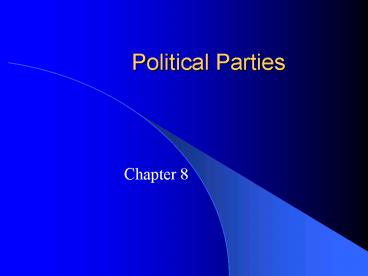Political Parties - PowerPoint PPT Presentation
1 / 22
Title:
Political Parties
Description:
... control the governing apparatus by gaining office in a duly constituted election. ... Linkage Institution: The channels through which people's concerns become ... – PowerPoint PPT presentation
Number of Views:40
Avg rating:3.0/5.0
Title: Political Parties
1
Political Parties
- Chapter 8
2
The Meaning of Party
- Political Party
- A team of men and women seeking to control the
governing apparatus by gaining office in a duly
constituted election. - Parties can be thought of in three parts
- Party in the electorate
- Party as an organization
- Party in government
3
The Meaning of Party
- Tasks of the Parties
- Linkage Institution The channels through which
peoples concerns become political issues on the
governments policy agenda. - Parties Pick Candidates
- Parties Run Campaigns
- Parties Give Cues to Voters
- Parties Articulate Policies
- Parties Coordinate Policymaking
4
The Meaning of Party
- Parties, Voters, and Policy The Downs Model
- Rational-choice theory Assumes that individuals
act in their own best interest, weighing the
costs benefits.
5
The Party in the Electorate
- Party identification is a citizens
self-proclaimed preference for one party or the
other. - Ticket-splitting
- Voting with one party for one office and with
another party for other offices. - Ticket-splitting has become the norm in American
voting behavior.
6
The Party in the Electorate
7
The Party Organizations From the Grass Roots to
Washington
- These are the people that work for the party.
- Local Parties
- Party Machines A type of political party
organization that relies heavily on material
inducements to win votes and to govern. - Patronage A job, promotion or contract given for
political reasons rather than merit. Used by
party machines. - Now urban party organizations are generally weak.
- County organizations have partially filled the
void.
8
The Party Organizations From the Grass Roots to
Washington
- The 50 State Party Systems
- Closed primaries voters must be registered with
their party in advance and can only vote for that
party - Open primaries voters decide on election day
which party to participate in, and then only that
party - Blanket primaries voters get a list of all
candidates and can vote for one name for each
office, regardless of party label - State party organizations are on an upswing in
terms of headquarters and budgets.
9
The Party Organizations From the Grass Roots to
Washington
- The National Party Organizations
- National Convention The meeting of party
delegates every four years to choose a
presidential ticket and the partys platform. - National Committee One of the institutions that
keeps the party operating between conventions. - National Chairperson Responsible for day-to-day
activities of the party.
10
The Party in Government Promises and Policy
- These are the party members actually elected to
government. - Candidates are less dependent on parties to get
elected, but they still need help. - Coalition
- A group of individuals with a common interest
upon which every political party depends. - Parties politicians generally do what they say
they will do.
11
The Party in Government Promises and Policy
12
Party Eras inAmerican History
- Party Eras
- Historical periods in which a majority of votes
cling to the party in power. - Critical Election
- An electoral earthquake where new issues and
new coalitions emerge. - Party Realignment
- The displacement of the majority party by the
minority party, usually during a critical
election.
13
Party Eras inAmerican History
- 1796-1824 The First Party System
- Madison warned of factions
- First party were the Federalists
- 1828-1856 Jackson and the Democrats Versus the
Whigs - Modern party founded by Jackson
- Whigs formed mainly in opposition to Democrats
14
Party Eras inAmerican History
- 1860-1928 The Two Republican Eras
- Republicans rose as the antislavery party
- 1896 election revolved around the gold standard
- 1932-1964 The New Deal Coalition
- Forged by the Democrats - relied upon urban
working class, ethnic groups, Catholics and Jews,
the poor, Southerners
15
Party Eras in American History
- Party Coalitions Today (Figure 8.2)
16
Party Eras in American History
- 1968-Present The Era of Divided Party Government
- Party dealignment - disengagement of people from
parties - Party neutrality - people are indifferent towards
the two parties
17
Party Eras in American History
- Partisan Control of State Governments 2005
(Figure 8.3)
18
Third Parties Their Impact on American Politics
- Political parties other than Democrat or
Republican - Rarely win elections
- Third parties bring new groups and ideas into
politics - Two-party system discourages extreme views
19
Third Parties Their Impact on American Politics
- Winner-take-all system
- Legislative seats awarded only to first place
finishers. - Proportional Representation
- Legislative seats awarded based on votes received
by the party - more votes, more seats - Coalition Government
- Two or more parties join to run government
20
Understanding Political Parties
- Democracy and Responsible Party Government
- 1. Parties have distinct comprehensive programs.
- 2. Candidates are committed to the program.
- 3. Majority party must carry out its program.
- 4. Majority party must accept responsibility.
21
Understanding Political Parties
- American Political Parties and the Scope of
Government - Lack of uniformity keeps government small
- But, it also makes cutting government programs
harder to do
22
Understanding Political Parties
- Is the Party Over?
- Political parties are no longer the chief source
of information for voters - State and national party organizations are
getting stronger - Majority of people still identify with a party,
but still split their tickets - Parties will continue to be around































